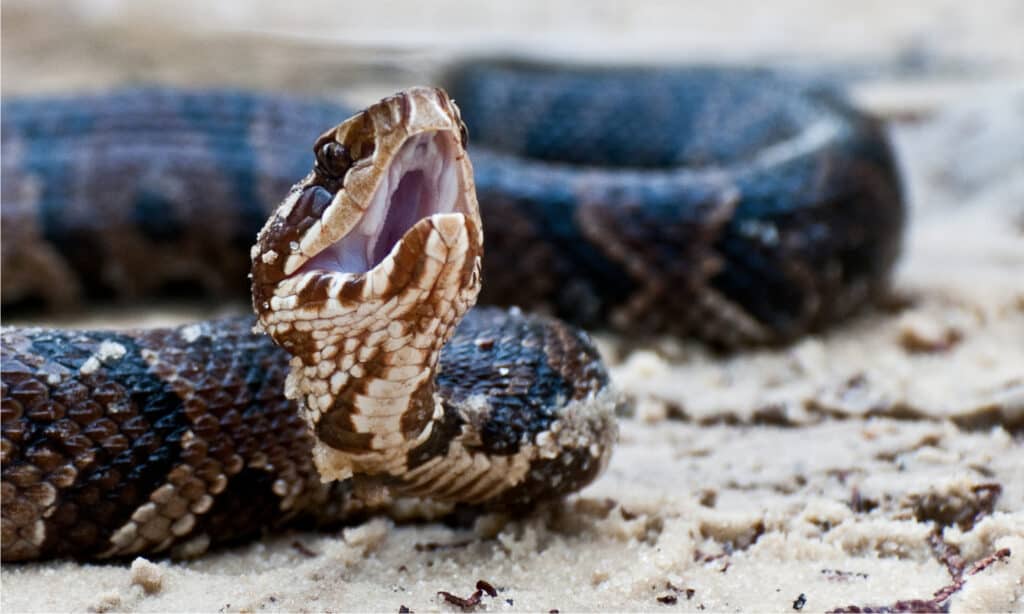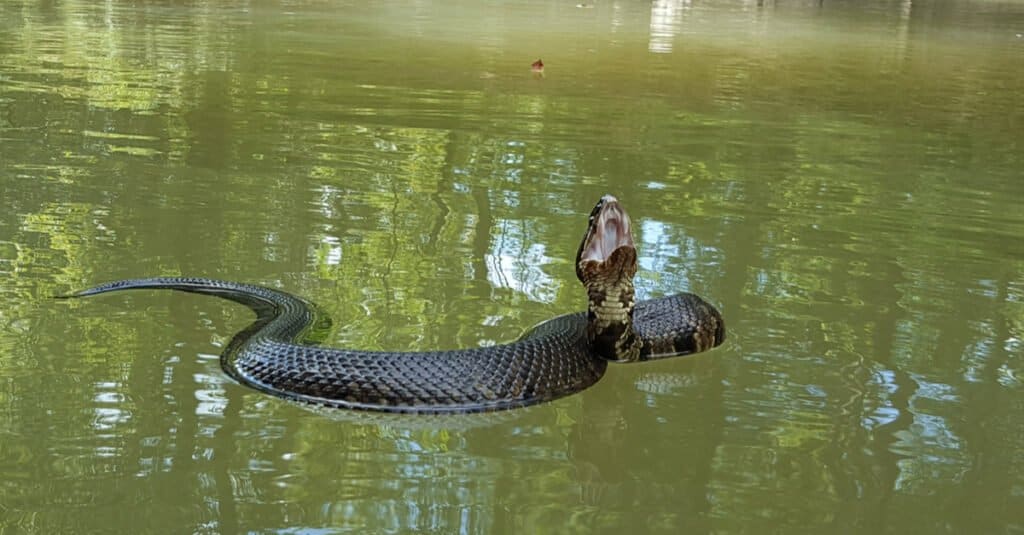The cottonmouth snake is named for its white mouth, which opens to display its fangs when a threat is present. Other nicknames for this snake include water moccasin, water mamba, and mangrove rattle.
When are you most likely to run into one of these venomous snakes, and how can you stay safe? Read on to find out when Florida cottonmouths are most active.
How Common Are Florida Cottonmouths?

The Everglades is the spot to go if you want to see snakes in the wild. This area is warm and has an abundance of food for cottonmouths.
©Jay Ondreicka/Shutterstock.com
The chances of running into a cottonmouth in Florida are high. Every single county in Florida has cottonmouths.
The Everglades is the spot to go if you want to see snakes in the wild. This area of Florida is warm and has an abundance of food for cottonmouths, coral snakes, copperheads, and eastern diamondback rattlesnakes! Cedar Keys, Florida is also known for having a lot of cottonmouths.
What Time of Day Are Cottonmouths Most Active?
Cottonmouths are nocturnal, which means they’re most active at night. Once the sun sets, cottonmouths begin hunting. But that doesn’t mean you won’t run into one during the daytime. These venomous snakes can be seen year-round in Florida’s swamps, marshes, ponds, lakes, and streams. The cottonmouth venom is highly toxic and can kill its prey almost instantly.
Can You Survive a Cottonmouth Bite?
You can survive a cottonmouth bite, but you’ll have to act fast. A bite from one of these venomous snakes is serious and requires immediate medical attention. Nearly 8,000 snake bites happen yearly, but there are rarely any fatalities. In fact, cottonmouths make up less than 1% of fatal annual snake bites.
Can Baby Cottonmouths Bite?
Baby cottonmouths can bite. Juvenile bites aren’t as serious as adult bites. However, if venom is injected from a baby cottonmouth snake, you should still seek medical attention immediately.
You can tell if you’re looking at a juvenile cottonmouth by observing the tip of the tail. Young cottonmouths have bright yellow tail tips to lure prey.
Are Cottonmouths Aggressive?
The chances of being bitten by a Florida cottonmouth are low. These water snakes might have a reputation for being aggressive, but there’s more to the story.
Cottonmouths snakes will avoid human encounters whenever possible. Whenever a bite does happen, it’s usually because the snake was startled. A scared cottonmouth will become aggressive and take a defensive stance.
If you ever come across one of these snakes, it may coil up and open its mouth. This is a warning! A scared cottonmouth will also shake its tail to imitate a rattlesnake, hoping to scare its threat away. As a last resort, cottonmouths will strike and inject their deadly venom.
Are Cottonmouths More Aggressive in Water?

There’s an old snake myth that cottonmouths can’t bite you if they’re in the water. This isn’t true.
©Seth LaGrange/Shutterstock.com
Cottonmouths aren’t more or less aggressive in the water. They behave the same way as they do on land. If there’s a threat, they respond with deadly force.
There’s an old myth that cottonmouths can’t bite you if they’re in the water. This isn’t true. They’re water snakes, and they can bite underwater. In fact, cottonmouths are very good at biting under the water because it’s often how they catch prey. They float near the surface of the water and then dive underneath to snatch up tasty frogs and fish.
Cottonmouths’ Jaws and Teeth
Cottonmouths have strong jaws and razor-sharp teeth. The force of their bite can rip through leather boots!
The good news is these venomous snakes don’t go out of their way to attack people or pets. As long as you do your part to give them space, you shouldn’t have any problems. Avoiding cottonmouths is the best way to prevent an attack.
Will a Cottonmouth Chase You?
Cottonmouths are one of the most misunderstood snakes in Florida. For instance, you may have heard that cottonmouths like chasing people. Maybe you’ve even had an encounter where a cottonmouth sped towards you and made your heart race.
Snake encounters are anxiety inducing and often misunderstood. Although it seems like the cottonmouth is chasing you, it’s trying to escape. These snakes will move in the direction of the closest cover. They don’t care if there’s a person in the way; they just want to get to safety.
Cottonmouths will crawl between legs and maneuver around people without trying to bite them. They understand that the best strategy for saving their life is to get away as quickly as possible.
How Cottonmouths Attack
Cottonmouths aren’t out to get humans, but they love hunting for birds, alligators, and turtles. When a cottonmouth attacks, it releases its venom immediately. After a quick bite, the snake lets go of its prey and gives the venom a chance to kick in. This helps avoid any chances of their prey biting them back. Alternatively, when a cottonmouth attacks aquatic prey, it does not release its jaws until the venom takes full effect.
Final Thoughts on Florida Cottonmouths
If you’re planning a trip to Florida, keep an eye open for cottonmouths. Even though they’re most active at night, you never know when you might see one during the day. Remember, avoiding these water snakes is the best way to protect yourself. Be vigilant when you’re out on the trail, and respond quickly to any bites.
Although Florida cottonmouths are known to be aggressive, they’re shy snakes. If you go out of your way to avoid them, they’ll go out of their way to avoid you. And remember, if you think a cottonmouth is chasing you, it’s just trying to escape! Move out of the way and let it pass.
Up Next
- Don’t Get Bit! Revealing 8 Snakes that Don’t Have Antivenom
- 10 Snakes in Florida
- Discover the Black Snakes in Florida
The photo featured at the top of this post is © iStock.com/Saddako
Discover the "Monster" Snake 5X Bigger than an Anaconda
Every day A-Z Animals sends out some of the most incredible facts in the world from our free newsletter. Want to discover the 10 most beautiful snakes in the world, a "snake island" where you're never more than 3 feet from danger, or a "monster" snake 5X larger than an anaconda? Then sign up right now and you'll start receiving our daily newsletter absolutely free.
Thank you for reading! Have some feedback for us? Contact the AZ Animals editorial team.






